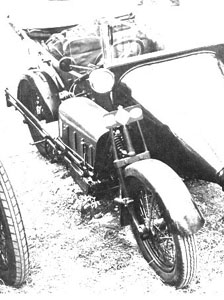

|
|

Part-assembled Gentleman's Combination Prototype "Cynthia" during development. Note H-P Patent Pillion Seat ("Designed by Medical Men") on offside-Wildebeeste chassis and steering wheel in "centrecar"
The recent discovery of a sizable tranche of H-P's long-lost Factory Archive in the Billiards Section of Belfast's Linenhall Thinking Orangeman's Library has illuminated a hitherto opaque facet of the Graet Marque's history: the development of that quintessential conveyance, the Outrigger Gentleman's Double Combination at Scunthorpe during 1936-37.
There were three Prototypes, coded in order, using Alaric Pugh's nicknames for his apprentices: "Eulalie", "Cynthia" and "Rosemary-Anne". The first,"Eulalie", was not an unqualified success. Cleverly, Pugh had married two Wildebeeste Excalibur Weathermen to a "centrecar". This featured a Cameroonian ebony frame with oriental-style wickerwork cladding. Linkages allowed her to be steered from either, or indeed both, riders' seats or the "centrecar", and the engines were joined by an extension to the right-hand end of the left-hand crankshaft, which was securely affixed to an extension to the left of the right-hand crankshaft, thus ensuring full synchronisation(and a power output, as a "wideline" vertical twin of 3,146cc, that was remarkable). The problem of lubricating the exposed wrought-Geranium bearings woven precisely into the wicker, to support the 3ft 7in crank extension coupling (which did not benefit from the Patent H-P Total Loss Lubemaster System), was solved by issuing the "centrecar" passenger with an oilcan.
The standard 199cc two-stroke Wally Whippet-derived starter motor not being up to the task of turning two mighty engines, the sidecar was fitted with a 798cc four-stroke starter - itself in turn fired up by a trusty 199cc Whippet - which drove directly on the central thrunging sprocket mounted alongside the exposed flywheel on the crankshaft extension. For some reason,Capt. Eric "Killer" Steerforth flatly refused to test the design, which was finally run up to an awesome 28.3 miles per hour by a Scunthorpe thrunging hand deputised for the job: "Simple" McGennitty. He did not survive the unfortunate crank coupling fracture.
"Cynthia" was a direct evolution from poor "Eulalie". Retaining and improving the inspirational "centrecar" design, but with a slightly sturdier brazed bronze chassis, Alaric housed both the power source and the driven wheel in it, centrally mounted at the rear. Reasoning that such a composite vehicle would require more torque and horsepower than the standard 1,820cc H-P single, he designed a vee-twin, incorporating integral supercharger and 8" open-throat, forged-Eboracum fuel injectors feeding a total of 5,529cc and producing a reported 634 Imperial Horsepower and 1460 stone/yds torque at a steady 43rpm. The engine drove the back wheel directly - with the clog available, there was no need for a gearbox. Instead of a clutch, a manly lever operated a spring-mounted collar, disengaging the drive from the hub. The Wildebeeste rolling chassis gracing either side enjoyed the same intricately-engineered and finished steering linkages as "Eulalie" and were both fitted with the remarkable H-P Patent Pillion Seat ("Designed by Medical Men"). On her first excursion, Steerforth mounted the right-hand chassis, snapped down his goggles and engaged the power, to watch dumb-struck as the "centrecar" broke free from the embrace of the Wildebeeste frames and hurtled down the Measured 3.2 Furlongs, accelerating hard until gyroscopic effect cartwheeled it, at an estimated 176.9mph, through the Thrunging Pit, the Management Offices, the Depot and finally the Sir John Hurley Boys' Club (fortunately only lightly occupied at the time).
After the Coroner's unhelpful remarks, Pugh was forced to concede that" Cynthia" had not been an unalloyed success either and retired to his studio- the "boudoir" - for some months, before emerging with "Rosemary-Anne",which, of course, was to be the prototype for the production Outriggers.
Cleverly inverting the "centrecar" concept, Pugh
arrived at the seminal outrigger double-sidecar design. The original
specification included a limited seagoing capability, to which
end the twin sidecars were proofed with paraffin wax over a clinker-built
Nasturtium frame - thus ensuring buoyancy at a slightly increased
risk of flammability. "Rosemary-Anne" went through three
"Marks". MkI succumbed to sparks from the Pugh-O-Spark
Magneto; MkII foundering off Immingham in a Force 8, before "Rosemary-Anne"
III was successfully piloted around a demanding 97-mile course,
including roads, canals and railway tracks, by Nat Benjamin, who
had been light-heartedly manacled to her by that consummate comedian
Steerforth. Concept proven, "R-A III" was wheeled into
the Frimbling Bay, serviced, and was (until the accidental RAF
carpet-bombings of September 16, 17 and 19,1943) a central exhibit
in the Sir John Hurley Museum of Motorcycles and Boyhood at the
Works. The rest is history.
"Ambrosianus"
[previous article][next article]